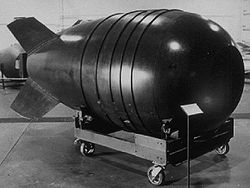
Mark 6 nuclear bomb
Encyclopedia

Mark 4 nuclear bomb
The Mark 4 nuclear bomb was an American nuclear bomb design produced starting in 1949 and in use until 1953.The Mark 4 was based on the earlier Mark 3 Fat Man design, used in the Trinity test and the bombing of Nagasaki...
and its predecessor, the Mark 3 Fat Man nuclear bomb
Fat Man
"Fat Man" is the codename for the atomic bomb that was detonated over Nagasaki, Japan, by the United States on August 9, 1945. It was the second of the only two nuclear weapons to be used in warfare to date , and its detonation caused the third man-made nuclear explosion. The name also refers more...
design.
The Mark 6 was produced from 1951-1955 and saw service until 1962. Seven variants and versions were produced, with a total production run of all models of 1100 bombs.
The basic Mark 6 design was 61 inches in diameter and 128 inches long, the same basic dimensions as the Mark 4 and close to the Mark 3. Various models weighed 7,600 to 8,500 pounds.
Early models of the Mark 6 utilized the same 32-point implosion system design concept as the earlier Mark 4 and Mark 3; the Mark 6 Mod 2 and later used a different, 60-point implosion system.
Various models and pit options gave nuclear yields of 8, 26, 80, 154, and 160 kilotons for Mark 6 models.
Survivors
A Mark 6 casing is on display in the Cold WarCold War
The Cold War was the continuing state from roughly 1946 to 1991 of political conflict, military tension, proxy wars, and economic competition between the Communist World—primarily the Soviet Union and its satellite states and allies—and the powers of the Western world, primarily the United States...
Gallery of the National Museum of the United States Air Force
National Museum of the United States Air Force
The National Museum of the United States Air Force is the official museum of the United States Air Force located at Wright-Patterson Air Force Base northeast of Dayton, Ohio. The NMUSAF is the world's largest and oldest military aviation museum with more than 360 aircraft and missiles on display...
in Dayton, Ohio
Dayton, Ohio
Dayton is the 6th largest city in the U.S. state of Ohio and the county seat of Montgomery County, the fifth most populous county in the state. The population was 141,527 at the 2010 census. The Dayton Metropolitan Statistical Area had a population of 841,502 in the 2010 census...
.
Mark 13
The Mark 13 nuclear bombMark 13 nuclear bomb
The Mark 13 nuclear bomb and its variant, the W-13 nuclear warhead, were experimental nuclear weapons developed by the United States from 1951 to 1954...
and W13 missile warhead were developed as higher efficiency Mark 6 successors, the same size and basic configuration as the Mark 6 but utilizing an improved 92-point implosion system. The Mark 13 was cancelled in August 1954 and the W13 cancelled September 1954, in both cases without ever seeing production service.
Mark 18
The Mark 18 nuclear bombMark 18 nuclear bomb
The Mark 18 nuclear bomb, also known as the SOB or Super Oralloy Bomb, was an American nuclear bomb design which was the highest yield fission bomb produced by the US. The Mark 18 had a design yield of 500 kilotons...
was a followon to the Mark 6 and Mark 13, utilizing a fissile pit assembly with around 60 kilograms of HEU and delivering a yield of 500 kilotons, the largest pure fission (non-thermonuclear) bomb design ever developed by the US. Mark 18 bombs were eventually recycled into Mark 6 Mod 6 bombs after thermonuclear weapons were deployed in quantity. The Mark 18 was tested once in Operation Ivy King
Ivy King
Ivy King was the largest pure fission nuclear bomb ever tested by the United States. The bomb was tested during the Truman administration as part of Operation Ivy...
.
External links
- Allbombs.html list of all US nuclear warheads at nuclearweaponarchive.org

